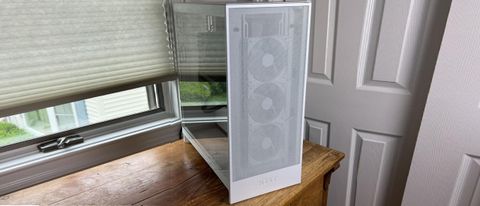Tom's Hardware Verdict
The overhauled NZXT H7 Flow gets a mesh front and a side-mounted power supply to make room for more fans. Its performance is still solid, but you’ll want to add your own fans to take advantage of the improved airflow options.
Pros
- +
Super easy to build in
- +
Room for 10 fans
- +
Lots of room for cables
Cons
- -
No dust filters
- -
Design feels a bit boring
Why you can trust Tom's Hardware
The H7 Flow is not a new chassis – in fact, it has been around for a couple of years now. However, the new 2024 iteration sports quite a few changes, like a different front panel, a side-mounted PSU, and room for 10 fans.
The new NZXT H7 Flow is available in black and white for $130, which feels like a fair price. But is the case any good, and is it worthy of a spot on our best PC cases list? We’ll put it through testing to find out, but first, let’s dig into the specs.
Specifications of the NZXT H7 Flow
| Type | ATX Mid-Tower |
| Motherboard Support | Mini-ITX, Micro ATX, ATX, E-ATX |
| Dimensions (HxWxD) | 24.1 x 9.6 x 18.4- inches |
| Max GPU Length | 16.4-inches |
| CPU Cooler Height | 7.28-inches |
| External Bays | X |
| Internal Bays | 2x 2.5-inch, 2x 3.5-inch |
| Expansion Slots | 7 |
| Front I/O | Two USB 3.2 Gen 1 Type-A (5Gbps), one USB 3.2 Gen 2 Type C (10Gbps) and a headset combo jack |
| Other | X |
| Front Side Fans | 3x 120mm |
| Rear Fans | None |
| Top Fans | None |
| Bottom Fans | None |
| Weight | 25 pounds |
| Warranty | 2 years |
Features of the NZXT H7 Flow
Just over two years ago, we looked at the NZXT H7 Flow and were impressed by its impressive thermals and not absurdly loud acoustics. Fast forward to 2024, and the new H7 Flow looks different, at least in some ways.
First off, the front panel is much more… meshy. It doesn’t look like a cheese grater like the original H7 Flow did back in 2022. Sure, the front of that case performed great, but I can see how it looked wonky to some. Also, with this design, you get the “NZXT chin” as I call it at the bottom of the front panel, which was missing in the 2022 variant.


If you’re familiar with the original H7 Flow, you might be asking yourself why the interior of the 2024 model looks kind of different, but also kind of the same. The answer: there’s no more PSU shroud. Instead, the PSU is mounted behind the motherboard tray, similar to the H6 Flow, or any dual-chamber design. This is one of the best new aspects of the redesigned H7 Flow, because you get more room for fans. But because it isn’t a true dual-chamber design, you don’t have to deal with that extra width that I don’t love about that kind of case design.

As you can see, NZXT has made room for the PSU like any other case, but forces you to flip your PSU on its side, allowing for bottom-mounted fans instead of a bulky PSU shroud. It’s also clear from the above photo how much storage space there is behind the motherboard tray.
Unlike most chassis these days, you don’t have to sacrifice 2.5-inch SSD’s for 3.5-inch hard drives. Instead, you can mount two SSDs in the cage and two hard drives behind the motherboard tray. Without factoring in how many M.2 SSDs you might install into your motherboard, you can fit four drives, which is beyond respectable for a mid-tower case like this. You can also use the 3.5-inch slots for 2.5-inch drives, should you decide to do so.
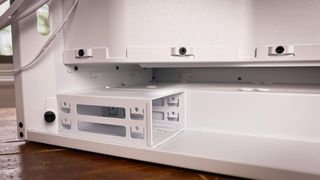
Thanks to the PSU being mounted behind the motherboard tray, the H7 Flow allows for a total of 10 fans, with radiator or fan support up to 420mm in the front, 360mm up top, and 140mm in the rear. NZXT doesn’t mention radiator support at the bottom, but you can mount three 120mm spinners there for direct GPU cooling.
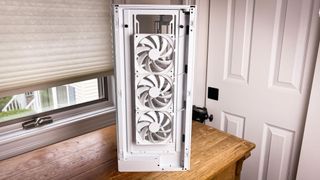
Speaking of GPUs, this chassis can house the largest cards, up to 410mm (16.14 - inches). CPU cooling space is abundant as well, with support for tower coolers up to 185mm (7.28 inches).
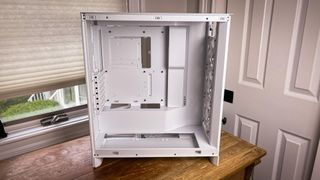
Usually, I don’t make a big deal about the amount of space granted behind the motherboard tray, but here because the PSU is mounted behind the tray, you’re still given 34.5mm (1.36 inches) of room to work with. So, yes, your sleeved cable extensions will fit, but you’ll need to make good use of the included straps for cable management.
The H7 Flow’s IO is what you’d expect from NZXT (and most companies in this price range): two USB Type-A, one Type-C, and a headset audio jack. Thankfully, all of these pesky IO cables are bridged into one header plug, making building even easier than it already was with the H7.
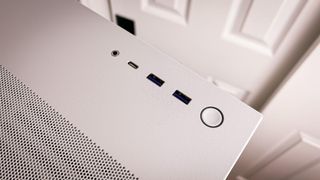
Testing Hardware
Our testing hardware uses Intel’s 12th Gen Alder Lake platform. We’re using a Core i7-12700KF, cooled by a Noctua U12s air cooler. Our graphics card is a Gigabyte RTX 3070 Ti Gaming OC, and our motherboard is the MSI Pro Z690-A WIFI.
Acoustic Results for the NZXT H7 Flow
Our acoustic test consists of three scenarios: We run the CPU at full load, the CPU and GPU at full load, and an optimized mode. The CPU full load test runs the CPU and case fans at their maximum speed. For the CPU and GPU full load acoustic test, we also stress the Gigabyte RTX 3070 Ti Gaming OC and set the fans at 75% speed, because in gaming, the fans never run at 100 percent and are far too loud when they do.
For the optimized mode, we run the GPU fan speed at 30%, and the CPU and included case fans at the lowest speed they will spin.
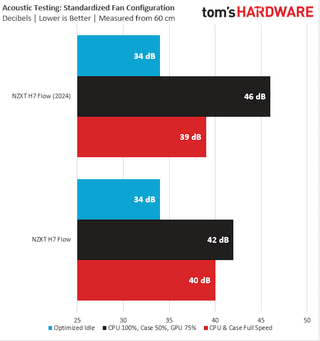
Interestingly enough, there isn’t a massive difference between the H7 Flow from 2022 and the new 2024 model with a different front panel. While the 2022 version is better with the GPU speed ramped up, at full speed, the new variant wins by a degree.
Thermal Results for the NZXT H7 Flow
For the thermal tests, all case and CPU fan speeds are set to 100%. The Core i7-12700K is set at a 4.7GHz clock at 1.3v on all performance cores to ensure consistent power consumption across test scenarios. Letting the GPU run at 75% fan speed enables it to maintain its power target while sticking to one set reasonable fan speed, so the temperature is the only variable.
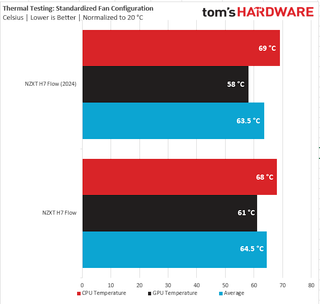
The difference in CPU temperature is nearly the same between the 2022 H7 Flow and the new model, but the GPU temperature differences are somewhat significant. Keep in mind that this test was conducted without fans mounted at the bottom of the case, because the case doesn’t come with fans there. So theoretically, temps will only improve if you decide to add your own fans at the bottom – which is something you couldn’t do with the previous model due to its PSU shroud.
Bottom Line
Both the original H7 Flow and the new 2024 model are solid case options if you’re in the market for a mid-range mid-tower case. The question is which should you buy while both versions are still available: the 2022 variant with its more open front panel, or the 2024 variant, which ditches the PSU shroud in favor of fan mounts at the bottom. While the 2024 variant is better looking in some ways, and allows for more cooling. But I personally still like the 2022 model. Fine mesh tends to be good for thermals, but it’s also on so many cases at this point that its addition here doesn’t help the case stand out visually. And considering this case is already a revamp of an existing chassis, it could use a little more in the way of novel design flourishes or… something else to help it feel fresh. In other words, it just feels like NZXT has played it safe with its update to the H7 Flow.
The 2024 NZXT H7 Flow is still a very solid chassis, especially if you plan to take advantage of its extra fan support. With hardware getting hotter and hotter, the mesh front and extensive fan options make this a good choice for NZXT enthusiasts and those looking for great thermals at low volumes.
MORE: Best PC Cases
MORE: Best Mini-ITX Cases

Myles Goldman is a freelance writer for Tom's Hardware US. He reviews keyboards and cases.

AMD Ryzen 9000 processors prices listed by French retailer — European Ryzen 9 9900X price at nearly $750

Intel cancels fab investment in Italy and R&D facility in France — chipmaker remains committed to other European expansions

Microsoft defends Game Pass price changes, tells FTC that adjustment offers multiplayer for less
-
Phaaze88 ReplyCons
-No dust filters
The panels serve as a filter anyway. This should allow for slightly better airflow than if they had filters.
Take some time to dust ya stuff out, ya lazybones.
My O11 Evo came with one filter, for the only place that could really use it: the bottom. Easy to remove and vacuum every week.
The top doesn't need one, and the side is occupied by the gpu using the upright kit.
